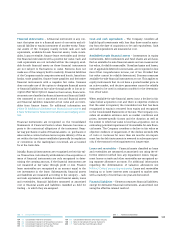Siemens 2011 Annual Report Download - page 262
Download and view the complete annual report
Please find page 262 of the 2011 Siemens annual report below. You can navigate through the pages in the report by either clicking on the pages listed below, or by using the keyword search tool below to find specific information within the annual report.
6 A. To our shareholders 51 C. Combined management’s discussion and analysis 23 B. Corporate Governance
the relationship with Siemens, the Company concludes that it
controls the SPE. To determine when the Company should
consolidate based on substance, Siemens considers the cir-
cumstances listed in SIC-. as additional indicators regard-
ing a relationship in which Siemens controls an SPE. Siemens
looks at these SIC-. circumstances as indicators and al-
ways privileges an analysis of individual facts and circum-
stances on a case-by-case basis. Associated companies are re-
corded in the Consolidated Financial Statements using the eq-
uity method of accounting. Companies in which Siemens has
joint control are also recorded using the equity method.
Business combinations – Business combinations are ac-
counted for under the acquisition method. Siemens as the ac-
quirer and the acquiree may have a relationship that existed
before they contemplated the business combination, referred
to as a pre-existing relationship. If the business combination
in effect settles a pre-existing relationship, Siemens as the ac-
quirer recognizes a gain or loss for the pre-existing relation-
ship. The cost of an acquisition is measured at the fair value
of the assets given and liabilities incurred or assumed at the
date of exchange. Any contingent consideration to be trans-
ferred by Siemens as the acquirer will be recognised at fair
value at the acquisition date. Subsequent changes to the fair
value of the contingent consideration that is deemed to be an
asset or liability will be recognised either in profit or loss or as
a change to other comprehensive income. If the contingent
consideration is classified as equity, it will not be remeasured;
subsequent settlement is accounted for within equity. Acqui-
sition-related costs are expensed in the period incurred. Iden-
tifiable assets acquired and liabilities assumed in a business
combination (including contingent liabilities) are measured
initially at their fair values at the acquisition date, irrespective
of the extent of any non-controlling interest. Uniform ac-
counting policies are applied. Non-controlling interests may
be measured at their fair value (full-goodwill-methodology) or
at the proportional fair value of assets acquired and liabilities
assumed. After initial recognition non-controlling interests
may show a deficit balance since both profits and losses are
allocated to the shareholders based on their equity interests.
In business combinations achieved in stages, any previously
held equity interest in the acquiree is remeasured to its acqui-
sition date fair value. If there is no loss of control, transac-
tions with non-controlling interests are accounted for as equi-
ty transactions not affecting profit and loss. At the date con-
trol is lost, any retained equity interests are re-measured to
fair value.
– Basis of presentation
The accompanying Consolidated Financial Statements pres-
ent the operations of Siemens AG with registered offices in
Berlin and Munich, Germany, and its subsidiaries (the Compa-
ny or Siemens). They have been prepared in accordance with
International Financial Reporting Standards (IFRS), as adopted
by the European Union as well as with the additional require-
ments as set forth in Section a () of the German Commer-
cial Code (HGB). The financial statements are also in accor-
dance with IFRS as issued by the International Accounting
Standards Board (IASB). Certain pronouncements have been
early adopted, see Note Summary of significant account-
ing policies – recently adopted accounting pronouncements.
Consolidated Financial Statements and Management’s discus-
sion and analysis as of September , and , prepared
in accordance with Section a () of the HGB are being filed
with and published in the German Electronic Federal Gazette
(elektronischer Bundesanzeiger).
Siemens prepares and reports its Consolidated Financial State-
ments in euros (€). Siemens is a German based multinational
corporation with a business portfolio of activities predomi-
nantly in the field of electronics and electrical engineering,
for further information see Note 37 Segment information.
The Consolidated Financial Statements were authorised for is-
sue by the Managing Board on November , . The Con-
solidated Financial Statements are generally prepared on the
historical cost basis, except as stated in Note 2 Summary of
significant accounting policies.
– Summary of
significant accounting policies
The accounting policies set out below have been applied con-
sistently to all periods presented in these Consolidated Finan-
cial Statements.
Basis of consolidation – The Consolidated Financial State-
ments include the accounts of Siemens AG and its subsidiar-
ies which are directly or indirectly controlled. Control is gener-
ally conveyed by ownership of the majority of voting rights.
Additionally, the Company consolidates special purpose enti-
ties (SPE’s) when, based on the evaluation of the substance of
























